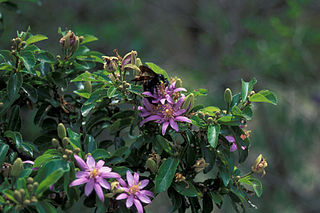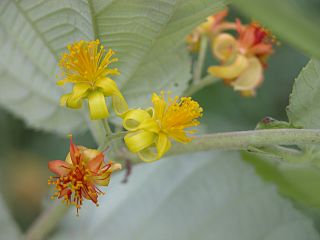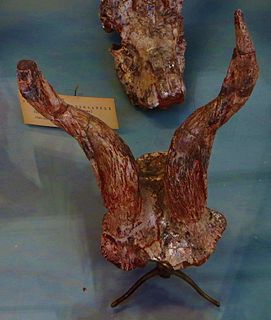
Bannerghatta National Park is a national park in India, located near Bangalore, Karnataka. It was founded in 1970 and declared as a national park in 1974. In 2002, a small portion of the park became a zoological garden, the Bannerghatta Biological Park.
Tiliaceae is a botanical name for a family of flowering plants. It is not a part of the APG, APG II and APG III classifications, being sunk in Malvaceae as a modified Tilioideae but has an extensive historical record of use.

The large flowering plant genus Grewia is today placed by most authors in the mallow family Malvaceae, in the expanded sense as proposed by the Angiosperm Phylogeny Group. Formerly, Grewia was placed in either the family Tiliaceae or the Sparrmanniaceae. However, these were both not monophyletic with respect to other Malvales - as already indicated by the uncertainties surrounding placement of Grewia and similar genera - and have thus been merged into the Malvaceae. Together with the bulk of the former Sparrmanniaceae, Grewia is in the subfamily Grewioideae and therein the tribe Grewieae, of which it is the type genus.

Grewia asiatica is a species of Grewia. It was first found in Varanasi India and was taken by Buddhist scholars to other Asian countries and the rest of the world. Grewia celtidifolia was initially considered a mere variety of Phalsa, but is now recognized as a distinct species.
Indigofera rothii is a species of plant in the family Fabaceae. It is found only in Ethiopia.

Oioceros is an extinct genus of spiral-horned antelope from the late Miocene. Its fossils have been found in Greece, China, Iran, and Africa. It was first discovered by Wagner in 1857, and contains nine species, O. rothii, O. atropatenes, O. jiulongkouensis, O. noverca, O. robustus, O. stenocephalus, O. lishanensis, O. wegneri, and O. tanyceras. Former species include O. grangeri, now recognized as the genus Sinomegoceros, and O. xiejiaensis, now recognized as the genus Sinopalaeoceros.

Grewia retusifolia is a shrub species in the family Malvaceae. Common names include dysentery bush, emu-berry, dog's balls, turkey bush and diddle diddle. It is widespread in tropical and subtropical areas of Eastern Australia and Northern Western Australia. The species produces small, sweet, two-lobed fruit with a fibrous acidic pulp surrounding the seeds. Leichhardt described the fruits as having a very agreeable taste, which could be boiled to make a refreshing drink. Indigenous Australians use the bark and leaves in medications. The crushed leaves were used as a poultice to relieve toothaches.

Ercheia cyllaria is a species of moth of the family Erebidae first described by Pieter Cramer in 1779. It is found in the Indian subregion, Sri Lanka, Taiwan, Japan, Indochina, Thailand, Peninsular Malaysia, Sumatra, Borneo, Seram and the Kai Islands.
The Central line of the Mumbai Suburban Railway is a public transit system serving Mumbai, Maharashtra, India. It consists of 24 stations from Chhatrapati Shivaji Maharaj Terminus to Kalyan Junction. The entire line is at grade. It has section of quadruple track starting from Chhatrapati Shivaji Maharaj Terminus and ends at Kasara, Roha, Uran and Khopoli in Maharashtra.

Serrodes partita, the catapult moth, is a moth of the family Erebidae. The species was first described by Johan Christian Fabricius in 1775. It is found in western, eastern, central and southern Africa, India, Indonesia and Sri Lanka.
The Achanakmar-Amarkantak Biosphere Reserve is a biosphere reserve in India that extends across the states of Madhya Pradesh and Chhattisgarh, covering a total area of 383,551 hectares (3835.51 km2).
Earias flavida is a moth of the family Nolidae. It was described by Cajetan Felder in 1861. It is found from the Indo-Australian tropics of India, Sri Lanka, Sumatra and Java to Samoa and Tonga.

The Mumbai–Chennai line is a railway line connecting Chennai and Mumbai cutting across southern part of the Deccan Plateau. It covers a distance of 1,281 kilometres (796 mi) across Maharashtra, Karnataka, Telangana, Andhra Pradesh and Tamil Nadu. The Mumbai–Chennai line is a part of Diamond Quadrilateral.
Eirenis rothii, known commonly as Roth's dwarf racer, is a species of snake in the family Colubridae. The species is endemic to the Middle East.
Anomis figlina is a moth of the family Erebidae first described by Arthur Gardiner Butler in 1889. It is found in Sri Lanka, India, Australia and Japan.

Andreaea rothii, or Roth's andreaea moss, is a species of moss in the family Andreaeaceae native to North America and parts of Europe. This plant was described in 1807 by Weber and Mohr.

Acacia rothii, commonly known as tooroo, Roth's wattle, lancewood and spoon tree, is a shrub of the genus Acacia and the subgenus Plurinerves that is endemic to an are in north eastern Australia.









